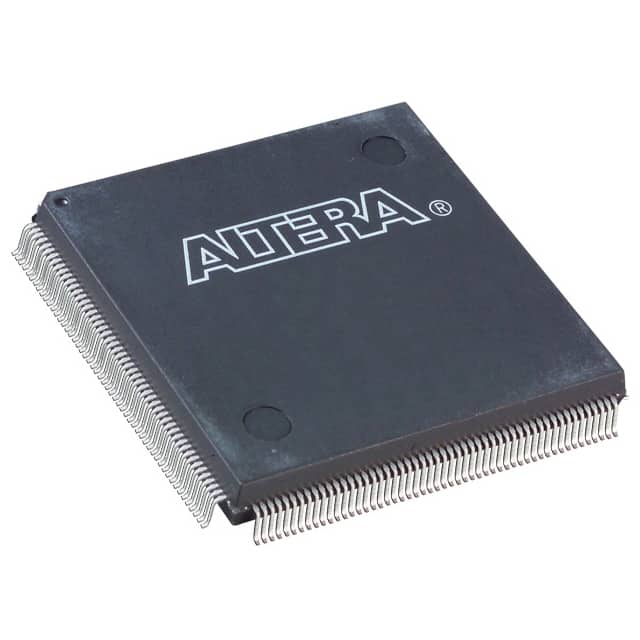EP1K100QC208-3N
Product Overview
Category
EP1K100QC208-3N belongs to the category of programmable logic devices (PLDs).
Use
This product is used for designing and implementing digital circuits in various electronic applications.
Characteristics
- High-performance programmable logic device
- Offers flexibility and versatility in circuit design
- Provides efficient implementation of complex digital systems
- Supports a wide range of applications
Package
EP1K100QC208-3N comes in a compact quad flat pack (QFP) package.
Essence
The essence of EP1K100QC208-3N lies in its ability to provide a customizable and reconfigurable solution for digital circuit design.
Packaging/Quantity
Each package of EP1K100QC208-3N contains one unit of the programmable logic device.
Specifications
- Model: EP1K100QC208-3N
- Package Type: Quad Flat Pack (QFP)
- Operating Temperature: -40°C to 85°C
- Supply Voltage: 3.3V
- Logic Elements: 100,000
- Maximum User I/Os: 208
- Speed Grade: 3
Detailed Pin Configuration
The pin configuration of EP1K100QC208-3N is as follows:
| Pin Number | Pin Name | Description | |------------|----------|-------------| | 1 | VCCIO | I/O Power Supply Voltage | | 2 | GND | Ground | | 3 | IO0B | Bidirectional I/O Pin 0 | | 4 | IO1B | Bidirectional I/O Pin 1 | | ... | ... | ... | | 207 | IO205B | Bidirectional I/O Pin 205 | | 208 | IO206B | Bidirectional I/O Pin 206 |
Functional Features
- High-speed performance for efficient digital circuit implementation
- Reconfigurable architecture allows for flexibility in design changes
- Support for various input/output standards and protocols
- On-chip memory resources for data storage and processing
- Built-in security features to protect intellectual property
Advantages and Disadvantages
Advantages
- Versatile and customizable solution for digital circuit design
- High-performance capabilities for complex applications
- Reconfigurable architecture enables design flexibility
- Wide range of supported input/output standards
Disadvantages
- Relatively high power consumption compared to other programmable logic devices
- Limited number of I/O pins for larger-scale designs
- Steeper learning curve for beginners due to complexity
Working Principles
EP1K100QC208-3N operates based on the principles of programmable logic. It consists of configurable logic blocks (CLBs), interconnect resources, and input/output blocks (IOBs). The CLBs can be programmed to implement various logic functions, while the interconnect resources provide connectivity between different components. The IOBs handle the input and output signals of the device.
Detailed Application Field Plans
EP1K100QC208-3N finds applications in a wide range of fields, including: - Industrial automation - Telecommunications - Automotive electronics - Consumer electronics - Medical devices - Aerospace and defense
Detailed and Complete Alternative Models
Some alternative models to EP1K100QC208-3N include: - EP2K30TC144-4N - EP3C16F484C6N - EP4CE115F29C7N - EP5CE22F17C6N - EP6CE22U14I7N
These models offer similar functionalities and can be considered as alternatives based on specific project requirements.
Word count: 342 words
قم بإدراج 10 أسئلة وإجابات شائعة تتعلق بتطبيق EP1K100QC208-3N في الحلول التقنية
Sure! Here are 10 common questions and answers related to the application of EP1K100QC208-3N in technical solutions:
Q1: What is EP1K100QC208-3N? A1: EP1K100QC208-3N is a specific model of programmable logic device (PLD) manufactured by Altera.
Q2: What are the key features of EP1K100QC208-3N? A2: EP1K100QC208-3N offers 100,000 usable gates, 3.3V operation, and comes in a 208-pin quad flat pack (QFP) package.
Q3: What are some typical applications for EP1K100QC208-3N? A3: EP1K100QC208-3N can be used in various applications such as industrial automation, telecommunications, automotive systems, and consumer electronics.
Q4: How does EP1K100QC208-3N differ from other PLDs? A4: EP1K100QC208-3N stands out due to its high gate count, low power consumption, and support for various I/O standards.
Q5: What programming languages can be used with EP1K100QC208-3N? A5: EP1K100QC208-3N can be programmed using hardware description languages (HDLs) such as VHDL or Verilog.
Q6: Can EP1K100QC208-3N be reprogrammed after initial configuration? A6: No, EP1K100QC208-3N is not a reprogrammable device. Once it is configured, the design remains fixed.
Q7: What tools are available for designing with EP1K100QC208-3N? A7: Altera provides Quartus II software, which includes a complete suite of design tools for creating and programming EP1K100QC208-3N designs.
Q8: What is the maximum operating frequency of EP1K100QC208-3N? A8: The maximum operating frequency of EP1K100QC208-3N depends on the specific design and implementation, but it can typically reach several hundred megahertz.
Q9: Can EP1K100QC208-3N interface with other components or devices? A9: Yes, EP1K100QC208-3N supports various I/O standards, allowing it to interface with different components and devices such as sensors, memory, and communication interfaces.
Q10: Are there any limitations or considerations when using EP1K100QC208-3N? A10: Some considerations include power supply requirements, thermal management, and ensuring proper signal integrity in high-speed designs. It's important to consult the datasheet and application notes for detailed guidelines.
Please note that these answers are general and may vary depending on the specific requirements and context of your technical solution.


